Popular categories
Looking for a yarn?

100% Wool
from 2.00 £ /50g
Order DROPS Needles & Hooks
Clicking the ORDER button will redirect you to Wool Warehouse Direct Ltd website
The yarn cost is calculated from the pattern’s smallest size and the yarn’s cheapest product type. Looking for an even better price? You might find it on the DROPS Deals!
The First Noel
Knitted bunting bag for baby and children in DROPS Snow. Piece is worked with hood and pompoms. Size 1 month - 4 years. Theme: Christmas
DROPS design: Pattern no ee-020-by
Yarn group E or C + C
-----------------------------------------------------------
Size: 1/3 – 6/9 – 12/18 months (2 – 3/4) years
Size in cm: 50/56 - 62/68 - 74/80 (86/92 - 98/104)
Materials:
DROPS SNOW from Garnstudio
500-550-600 (650-750) g colour no 56, Christmas red
50 g for all sizes in colour no 01, off white
DROPS CIRCULAR NEEDLE (80 cm) SIZE 8 mm - or size needed to get 11 sts x 15 rows in stocking st = 10 x 10 cm.
DROPS HEART BUTTON, NO 553: 5-5-5 (5-6) pieces
-------------------------------------------------------
Alternative Yarn – See how to change yarns here
Yarn Groups A to F – Use the same pattern and change the yarn here
Yarn usage using an alternative yarn – Use our yarn converter here
-------------------------------------------------------

100% Wool
from 2.00 £ /50g
Order DROPS Needles & Hooks
Clicking the ORDER button will redirect you to Wool Warehouse Direct Ltd website
The yarn cost is calculated from the pattern’s smallest size and the yarn’s cheapest product type. Looking for an even better price? You might find it on the DROPS Deals!
- English (UK/cm)
- Česky
- Dansk
- Deutsch
- Eesti keel
- English (US/in)
- Español
- Français
- Íslenska
- Italiano
- Magyar
- Nederlands
- Norsk
- Polski
- Português
- Suomi
- Svenska
- English (UK/cm), Bulgaria
- English (UK/cm), Croatia
- English (UK/cm), Greece
- English (UK/cm), Latvia
- English (UK/cm), Lithuania
- English (UK/cm), Romania
- English (UK/cm), Slovenia
- Česky, Slovakia
Pattern instructions
K all rows. 1 ridge = 2 rows K.
INCREASE TIP:
Inc by making 1 YO. On next round work YO twisted, i.e. work in the back loop of st, to avoid holes.
HOLE FOR SEAT BELT IN CAR SEAT:
You can make a hole at the front and back for the belt in the car seat.
Make the first hole on back piece when piece measures approx. 16-20-23 (28-33) cm (or desired measurements) by casting off the middle 4 sts on needle.
On next row cast on 4 new sts over the cast off sts and continue as before.
Repeat on front piece when piece measures from shoulder 42-47-52 (58-59) cm.
BUTTONHOLES:
Dec for buttonholes on right band.
1 buttonhole = cast off third st from mid front and cast on 1 new st over the cast off st on next row.
Dec for buttonholes when band measures:
SIZE 1/3 months: 1, 6, 10, 14 and 19 cm
SIZE 6/9 months: 1, 5, 10, 15 and 20 cm
SIZE 12/18 months: 1, 6, 11, 16 and 21 cm
SIZE 2 years: 1, 7, 12, 17 and 22 cm
SIZE 3/4 years: 1, 6, 10, 14, 18 and 23 cm.
----------------------------------------------------------
BUNTING BAG:
Work bag in one - beg at bottom of back piece, cast on sts for sleeve, dec for neck and finish at the bottom of front piece. Worked back and forth on a circular needle to make room for all the sts. If you want you can make a HOLE FOR SEAT BELT IN CAR SEAT - see explanation above.
BACK PIECE:
Cast on 36-40-44 (46-50) sts (incl 1 edge st in each side) on circular needle size 8 mm with Christmas red. Work 3 ridges in garter st - SEE EXPLANATION ABOVE. Continue in stocking st until piece measures 37-45-52 (62-67) cm – AT THE SAME TIME on last row dec 4 sts evenly = 32-36-40 (42-46) sts. REMEMBER THE KNITTING TENSION!
Work 3 ridges over all sts, continue in stocking st. When piece measures 46-54-61 (71-76) cm, cast on new sts in each side for sleeves. Cast on sts at the end of every row: 4 sts 1 time, 5 sts 1-1-1 (2-2) times and 9-10-12 (12-16) sts 1 time = 68-74-82 (94-106) sts. Work the new sts in stocking st. NOTE! After last inc work the outermost 3 sts in each side (= at the bottom of sleeve) in garter st.
When piece measures 54-63-71 (82-88) cm, continue as follows: 3 sts in garter st, 19-22-25 (31-37) sts in stocking st, 24-24-26 (26-26) sts in garter st (= back of neck), 19-22-25 (31-37) sts in stocking st, 3 sts in garter st. When 3 ridges have been worked over sts in the back of neck, cast off the middle 12-12-14 (14-14) sts for neck and finish each side separately. Slip sts in the right side on 1 stitch holder.
LEFT FRONT PIECE:
= 28-31-34 (40-46) sts. Continue in stocking st with 6 sts in garter st towards the neck and 3 sts in garter st at the bottom of sleeve. When piece measures 58-67-75 (86-92) cm, insert 1 marker = mid on top of shoulder - NOW MEASURE PIECE FROM HERE!
Work as before. When piece measures 1-1-2 (2-2) cm, inc 1 st towards the neck on next row from RS inside 6 sts in garter st - see INCREASE TIP. Work 1 row from WS and repeat inc on next row from RS. Work 1 row from WS, at the end of this row cast on 7-7-8 (8-8) new sts towards mid front = 37-40-44 (50-56) sts. Work 1 ridge in garter st over the 7-7-8 (8-8) new sts, work the other sts as before. Then work in stocking st with 6 sts in garter st towards mid front (= band) and 3 sts in garter st at the bottom of sleeve. When piece measures 8-9-10 (11-12) cm, cast off sleeve sts, cast off in the side at beg of row as follows: 9-10-12 (12-16) sts 1 time, 5 sts 1-1-1 (2-2) times and 4 sts 1 time = 19-21-23 (24-26) sts. Continue in stocking st with 6 band sts until piece measures approx. 18-19-20 (21-22) cm (fold the piece double at the marker on shoulder and make sure to work same no of row in stocking st on back and front piece) – adjust so that next row is worked from RS. Work 3 ridges in garter st over all sts. Work 2 rows while continuing stocking st and band sts in garter st – AT THE SAME TIME on 1st row inc 2 sts evenly (do not inc over band) = 21-23-25 (26-28) sts. Slip sts on a stitch holder.
RIGHT FRONT PIECE:
Slip the stitches on the stitch holder back on needle (= 28-31-34 (40-46) sts) and work as left front piece but reversed.
Then slip sts from left front piece on to same needle = 42-46-50 (52-56) sts. On next row (= RS) dec band sts tog as follows: Work in stocking st over the first 15-17-19 (20-22) sts, slip 6 band sts from right front piece on a cable needle in front of piece, * K 1 st from cable needle tog with 1 st from left band *, repeat from *-* 6 times = 6 sts dec, then work in stocking st the rest of row = 36-40-44 (46-50) sts. Continue in stocking st over all sts. When piece measures approx. 55-64-72 (83-89) cm (fold piece at the marker on the shoulder and make sure that front and back pieces are the same length except the 3 bottom ridges on back piece). Work 3 ridges in garter st over all sts. LOOSELY cast off.
ASSEMBLY:
Fold piece double at the shoulder and sew under arm and side seams inside 1 edge st.
Sew cast-on edge to cast-off edge at the bottom of back - sew edge to edge to avoid a chunky seam. Sew bottons on left front piece.
HOOD:
Pick up 37-39-41 (45-47) sts with Christmas red on circular needle size 8 mm around the neck (beg mid front and pick up in outer loops of edge sts from RS). Work in garter st back and forth on needle until hood measures 18-20-22 (24-26) cm. LOOSELY cast off.
Sew hood tog edge to edge at the top.
POMPOMS AND TIE:
Make 2 small pompoms in off white with a diameter of approx. 6 cm and 1 large pompom with a diameter of 8 cm. Pompoms should not be too compact. Cut 1 strand of approx. 1 m, fold it double and twine the strand. Fasten tie to 1 small pompom, sew the other end to band by first threading it through band. Make another the same way but fasten in the opposite band. Fasten the large pompom at the top of hood.
Fold the sleeves if necessary.
Diagram
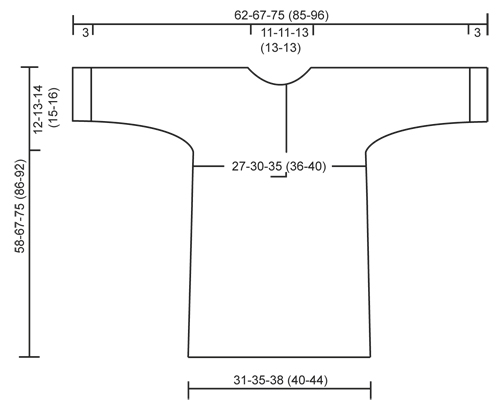
What can you do with our patterns? You can share DROPS patterns online, using the pattern original picture, materials, name and number. But you are NOT ALLOWED to reproduce the complete pattern digitally in any way. Yarn stores are welcome to use the DROPS pattern database to promote the sale of our assortment. You can print out our patterns, make as many copies as you’d like. The only thing we ask is that you don't make any changes / additions to the original printed document. And that the patterns according to the DROPS philosophy are given out to the consumers for free. Editorials that wish to publish our patterns in printed books or magazines can contact us for more information. The sale of garments based on DROPS patterns is permitted as long as they are sold as single items or per order. Further commercial use of the patterns is not permitted. It has to be clearly stated that the garment is made based on a design from DROPS DESIGN. The use of clothing labels of which DROPS DESIGN forms part is conditioned by the inclusion of the following text: “A DROPS DESIGN made by …..”. The use of DROPS photos for marketing purposes/sales is only permitted in connection with the use/sale of DROPS products. The photos may not be cut or edited and the logo should be clearly visible.
We reserve the right to withdraw the permission for use of our patterns at any time, notwithstanding the reason.
Each of our patterns has specific tutorial videos to help you.
These step-by-step tutorials might also help you:
Why is the knitting/crochet tension so important?
Knitting tension is what determines the final measurements of your work, and is usually measured per 10 x 10 cm. It is provided like so: number of stitches in width x number of rows in height - eg: 19 stitches x 26 rows = 10 x 10 cm.
The knitting tension is very individual; some people knit/crochet loosely while others work tightly. You adjust the knitting tension with the needle size, which is why the suggested needle size is only meant as a guide! You need to adjust this (up or down) to ensure that YOUR knitting tension matches the knitting tension provided in the pattern. If you work with a different knitting tension than provided you will have a different yarn consumption, and your work will have different measurements than what the pattern suggests.
The knitting tension also determines which yarns can replace each other. As long as you achieve the same knitting tension you can replace one yarn with another.
See DROPS lesson: How to measure your tension/gauge
See DROPS video: How to make a gauge tension swatch
How do I know how many balls of yarn I need?
The required amount of yarn is provided in grams, eg: 450 g. To calculate how many balls you’ll need you first need to know how many grams are in 1 ball (25g, 50g or 100g). This information is available if you click on the individual yarn quality on our pages. Divide the amount required with the amount of each ball. For example, if each ball is 50g (the most common amount), the calculation will be as follows: 450 / 50 = 9 balls.
Can I use a different yarn than what the pattern suggests?
The important thing when changing from one yarn to another is that the knitting/crochet tension remains the same. This is so that the measurements of the finished piece will be the same as on the sketch provided. It is easier to achieve the same knitting tension using yarns from the same yarn group. It is also possible to work with multiple strands of a thinner yarn to achieve the knitting tension of a thicker one. Please try our yarn converter. We recommend you to always work a test swatch.
Please NOTE: when changing yarn the garment might have a different look and feel to the garment in the photo, due to individual properties and qualities of each yarn.
See DROPS lesson: Can I use a different yarn than the one mentioned in the pattern?
What are the yarn groups?
All our yarns are categorised into yarn groups (from A to F) according to thickness and knitting tension – group A contains the thinnest yarns and group F the thickest. This makes it easier for you to find alternative yarns to our patterns, should you wish to switch yarn. All yarns within the same group have a similar knitting tension and can easily replace each other. However, different yarn qualities have different structures and properties which will give the finished work a unique look and feel.
How do I use the yarn calculator?
At the top of all our patterns you’ll find a link to our yarn calculator, which is a helpful tool should you wish to use a different yarn than suggested. By filling in the yarn quality you wish to replace, the amount (in your size) and number of strands, the calculator will present good alternative yarns with the same knitting tension. Additionally it will tell you how much you’ll require in the new qualities and whether you’ll need to work with multiple strands. Most skeins are 50g (some are 25g or 100g).
If the pattern is worked with multiple colours, every colour will have to be calculated separately. Similarly, if the pattern is worked with several strands of different yarns (for example 1 strand Alpaca and 1 strand Kid-Silk) you will have to find alternatives for each, individually.
Why do you show discontinued yarns in the patterns?
Since different yarns have different qualities and textures we have chosen to keep the original yarn in our patterns. However, you can easily find options among our available qualities by using our yarn calculator, or simply pick a yarn from the same yarn group.
It is possible that some retailers still have discontinued yarns in stock, or that someone has a few skeins at home that they would like to find patterns for.
The yarn calculator will provide both alternative yarn as well as required amount in the new quality.
What size should I knit?
If you think it's hard to decide what size to make, it can be a good idea to measure a garment you own already and like the size of. Then you can pick the size by comparing those measures with the ones available in the pattern's size chart.
You'll find the size chart at the bottom of the pattern.
See DROPS lesson: How to read size chart
Why do I get the wrong knitting tension with the suggested needle size?
The needle size provided in the pattern serves only as a guide, the important thing is to follow the knitting tension. And since knitting tension is very individual, you will have to adjust the needle size to ensure that YOUR tension is the same as in the pattern – maybe you’ll have to adjust 1, or even 2 needle sizes, up or down to achieve the correct tension. For this, we recommend that you work test swatches.
Should you work with a different knitting tension than the one provided, the measurements of the finished garment might deviate from the measurement sketch.
See DROPS lesson: How to measure your tension/gauge
See DROPS video: How to make a tension/gauge swatch
Why is the pattern worked top-down?
Working a garment top-down provides more flexibility and room for personal adjustment. For example it is easier to try the garment on while working, as well as making adjustments to length of yoke and shoulder caps.
The instructions are carefully explaining every step, in the correct order. Diagrams are adjusted to the knitting direction and are worked as usual.
How do I work according to a knitting diagram?
The diagram depicts all rows/rounds, and every stitch seen from the right side. It is read from bottom to top, from right to left. 1 square = 1 stitch.
When working back and forth, every other row is worked from the right side and every other row is worked from the wrong side. When working from the wrong side, the diagram will have to be worked reversed: from left to right, knit stitches are purled, purl stitches are knit etc.
When working in the round every round is worked from the right side and the diagram are worked from right to left on all rounds.
See DROPS lesson: How to read knitting diagrams
How do I work according to a crochet diagram?
The diagram depicts all rows/rounds, and every stitch seen from the right side. It is worked from bottom to top, from right to left.
When working back and forth every other row is worked from the right side: from right to left and every other row is worked from the wrong side: from left to right.
When working in the round, every row in the diagram are worked from the right side, from right to left.
When working a circular diagram you start in the middle and work your way outwards, counter clockwise, row by row.
The rows usually start with a given number of chain stitches (equivalent to the height of the following stitch), this will either be depicted in the diagram or explained in the pattern.
See DROPS lesson: How to read crochet diagrams
How do I work several diagrams simultaneously on the same row/round?
Instructions for working several diagrams after each other on the same row/round, will often be written like so: “work A.1, A.2, A.3 a total of 0-0-2-3-4 times". This means you work A.1 once, then A.2 is worked once, and A.3 is repeated (in width) the number of times provided for your size – in this case like so: S = 0 times, M = 0 times, L=2 times, XL= 3 times and XXL = 4 times.
The diagrams are worked as usual: begin with the first row in A.1, then work the first row in A.2 etc.
See DROPS lesson: How to read knitting diagrams
See DROPS lesson: How to read crochet diagrams
Why are the sleeves shorter in larger sizes?
The total width of the garment (from wrist-to-wrist) will be larger in the larger sizes, despite the actual sleeves being shorter. The larger sizes have longer sleeve caps and wider shoulders, so there will be a good fit in all sizes.
Where on the garment is the length measured?
The measurement sketch/schematic drawing provides information regarding the full length of the garment. If it’s a jumper or a jacket the length is measured from the highest point on the shoulder closest to the neckline, and straight down to the bottom of the garment. It is NOT measured from the tip of shoulder. Similarly, the length of yoke is measured from the highest point on the shoulder and down to where yoke is split into body and sleeves.
On a jacket measures are never taken along bands, unless specifically stated. Always measure inside band stitches when measuring the length.
See DROPS lesson: How to read a schematic drawing
What is a repeat?
Diagrams are often repeated on the round or in height. 1 repeat is the diagram the way it appears in the pattern. If it says to work 5 repeats of A.1 in the round, then you work A.1 a total of 5 times after/next to each other in the round. If it says to work 2 repeats of A.1 vertically/in height you work the entire diagram once, then begin again at the start and work the entire diagram one more time.
Why does the piece start with more chain stitches than it’s worked with?
Chain stitches are slightly narrower than other stitches and to avoid working the cast-on edge too tight, we simply chain more stitches to begin with. The stitch count will be adjusted on the following row to fit the pattern and measurement sketch.
Why increase before the rib edge when the piece is worked top-down?
The rib edge is more elastic and will contract slightly compared to, for example, stocking stitch. By increasing before the rib edge, you avoid a visible difference in width between the rib edge and the rest of the body.
Why increase in the cast-off edge?
It’s very easy to cast off too tightly, and by making yarn overs while casting off (and simultaneously casting these off) you avoid a too tight cast off edge.
See DROPS video: How to bind off with yarn overs (yo)
How do I increase/decrease on every 3rd and 4th row/round alternately?
To achieve an even increase (or decrease) you can increase on, for example: every 3rd and 4th row alternately, like so: work 2 rows and increase on the 3rd row, work 3 rows and increase on the 4th. Repeat this until the increase is complete.
See DROPS lesson: Increase or decrease 1 st on every 3rd and 4th row alternately
How can I work a jacket in the round instead of back and forth?
Should you prefer to work in the round instead of back and forth, you may of course adjust the pattern. You’ll need to add steeks mid-front (usually 5 stitches), and follow the instructions. When you would normally turn and work from the wrong side, simply work across the steek and continue in the round. At the end you’ll cut the piece open, pick up stitches to work bands, and cover the cut edges.
See DROPS video: How to knit steeks and cut open
Can I work a jumper back and forth instead of in the round?
Should you prefer to work back and forth instead of in the round, you may of course adjust the pattern so you work the pieces separately and then assemble them at the end. Divide the stitches for the body in 2, add 1 edge stitch in each side (for sewing) and work the front and back pieces separately.
See DROPS lesson: Can I adapt a pattern for circular needles into straight needles?
Why is the pattern slightly different than what I see in the photo?
Pattern repeats can vary slightly in the different sizes, in order to get the correct proportions. If you’re not working the exact same size as the garment in the photo, yours might deviate slightly. This has been carefully developed and adjusted so that the complete impression of the garment is the same in all sizes.
Make sure to follow instructions and diagrams for your size!
How do I make a women’s size garment into a men’s size one?
If you have found a pattern you like which is available in women’s size it’s not very difficult to convert it to men’s size. The biggest difference will be the length of sleeves and body. Start working on the women size that you think would fit across the chest. The additional length will be worked right before you cast off for the armhole/sleeve cap. If the pattern is worked top-down you can add the length right after the armhole or before the first decrease on sleeve.
Regarding additional yarn amount, this will depend on how much length you add, but it is better with a skein too many than too few.
How do I prevent a hairy garment from shedding?
All yarns will have excess fibres (from production) that might come off as lint or shedding. Brushed yarns (ie hairier yarns) have more of these loose, excess fibres, causing more shedding.
Shedding also depends on what is worn under or over the garment, and whether this pulls at the yarn fibres. It’s therefore not possible to guarantee that there will be no shedding
Below are some tips on how to get the best result when working with hairier yarns:
1. When the garment is finished (before you wash it) shake it vigorously so the looser hairs come off. NOTE: do NOT use a lint roller, brush or any method that pulls at the yarn.
2. Place the garment in a plastic bag and put it in your freezer - the temperature will cause the fibres to become less attached to each other, and excess fibres will come off easier.
3. Leave in the freezer for a few hours before taking it out and shaking it again.
4. Wash the garment according to the instructions on the yarn label.
Why does my garment pill?
Pilling is a natural process that happens to even the most exclusive of fibers. It's a natural sign of wear and tear that is hard to avoid, and that is most visible in high friction areas of your garment like a sweater's arms and cuffs.
You can make your garment look as new by removing the pilling, using a fabric comb or a pill/lint remover.
In the meantime, you can read the questions and answers that others have left to this pattern or join the DROPS Workshop on Facebook to get help from fellow knitters/crocheters!
The First Noel |
|
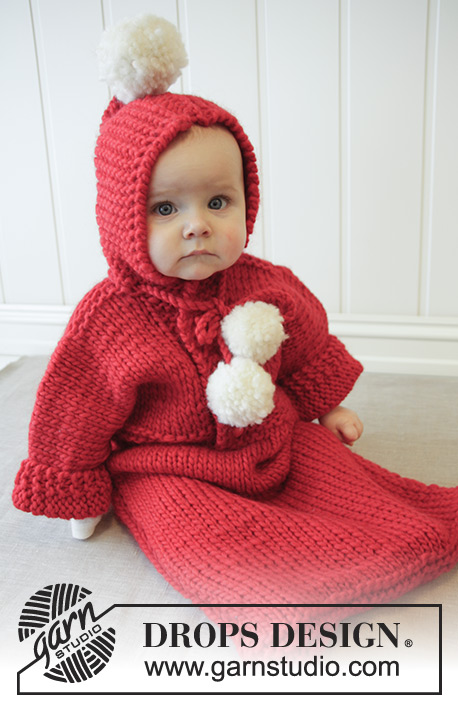 |
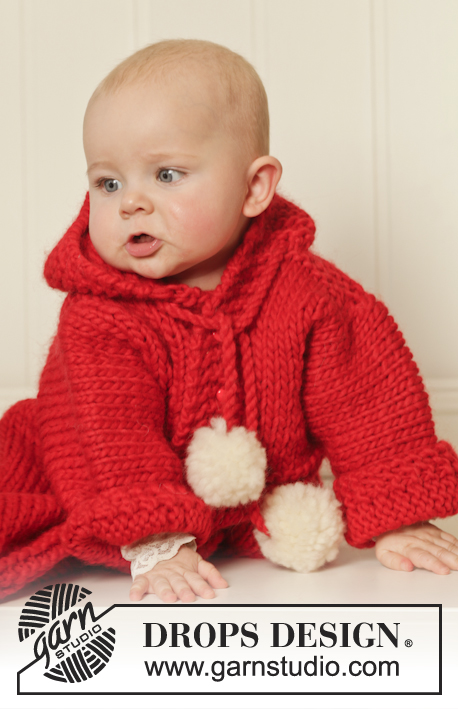 |
Knitted bunting bag for baby and children in DROPS Snow. Piece is worked with hood and pompoms. Size 1 month - 4 years. Theme: Christmas
DROPS Extra 0-1052 |
|
|
GARTER ST (back and forth): K all rows. 1 ridge = 2 rows K. INCREASE TIP: Inc by making 1 YO. On next round work YO twisted, i.e. work in the back loop of st, to avoid holes. HOLE FOR SEAT BELT IN CAR SEAT: You can make a hole at the front and back for the belt in the car seat. Make the first hole on back piece when piece measures approx. 16-20-23 (28-33) cm (or desired measurements) by casting off the middle 4 sts on needle. On next row cast on 4 new sts over the cast off sts and continue as before. Repeat on front piece when piece measures from shoulder 42-47-52 (58-59) cm. BUTTONHOLES: Dec for buttonholes on right band. 1 buttonhole = cast off third st from mid front and cast on 1 new st over the cast off st on next row. Dec for buttonholes when band measures: SIZE 1/3 months: 1, 6, 10, 14 and 19 cm SIZE 6/9 months: 1, 5, 10, 15 and 20 cm SIZE 12/18 months: 1, 6, 11, 16 and 21 cm SIZE 2 years: 1, 7, 12, 17 and 22 cm SIZE 3/4 years: 1, 6, 10, 14, 18 and 23 cm. ---------------------------------------------------------- BUNTING BAG: Work bag in one - beg at bottom of back piece, cast on sts for sleeve, dec for neck and finish at the bottom of front piece. Worked back and forth on a circular needle to make room for all the sts. If you want you can make a HOLE FOR SEAT BELT IN CAR SEAT - see explanation above. BACK PIECE: Cast on 36-40-44 (46-50) sts (incl 1 edge st in each side) on circular needle size 8 mm with Christmas red. Work 3 ridges in garter st - SEE EXPLANATION ABOVE. Continue in stocking st until piece measures 37-45-52 (62-67) cm – AT THE SAME TIME on last row dec 4 sts evenly = 32-36-40 (42-46) sts. REMEMBER THE KNITTING TENSION! Work 3 ridges over all sts, continue in stocking st. When piece measures 46-54-61 (71-76) cm, cast on new sts in each side for sleeves. Cast on sts at the end of every row: 4 sts 1 time, 5 sts 1-1-1 (2-2) times and 9-10-12 (12-16) sts 1 time = 68-74-82 (94-106) sts. Work the new sts in stocking st. NOTE! After last inc work the outermost 3 sts in each side (= at the bottom of sleeve) in garter st. When piece measures 54-63-71 (82-88) cm, continue as follows: 3 sts in garter st, 19-22-25 (31-37) sts in stocking st, 24-24-26 (26-26) sts in garter st (= back of neck), 19-22-25 (31-37) sts in stocking st, 3 sts in garter st. When 3 ridges have been worked over sts in the back of neck, cast off the middle 12-12-14 (14-14) sts for neck and finish each side separately. Slip sts in the right side on 1 stitch holder. LEFT FRONT PIECE: = 28-31-34 (40-46) sts. Continue in stocking st with 6 sts in garter st towards the neck and 3 sts in garter st at the bottom of sleeve. When piece measures 58-67-75 (86-92) cm, insert 1 marker = mid on top of shoulder - NOW MEASURE PIECE FROM HERE! Work as before. When piece measures 1-1-2 (2-2) cm, inc 1 st towards the neck on next row from RS inside 6 sts in garter st - see INCREASE TIP. Work 1 row from WS and repeat inc on next row from RS. Work 1 row from WS, at the end of this row cast on 7-7-8 (8-8) new sts towards mid front = 37-40-44 (50-56) sts. Work 1 ridge in garter st over the 7-7-8 (8-8) new sts, work the other sts as before. Then work in stocking st with 6 sts in garter st towards mid front (= band) and 3 sts in garter st at the bottom of sleeve. When piece measures 8-9-10 (11-12) cm, cast off sleeve sts, cast off in the side at beg of row as follows: 9-10-12 (12-16) sts 1 time, 5 sts 1-1-1 (2-2) times and 4 sts 1 time = 19-21-23 (24-26) sts. Continue in stocking st with 6 band sts until piece measures approx. 18-19-20 (21-22) cm (fold the piece double at the marker on shoulder and make sure to work same no of row in stocking st on back and front piece) – adjust so that next row is worked from RS. Work 3 ridges in garter st over all sts. Work 2 rows while continuing stocking st and band sts in garter st – AT THE SAME TIME on 1st row inc 2 sts evenly (do not inc over band) = 21-23-25 (26-28) sts. Slip sts on a stitch holder. RIGHT FRONT PIECE: Slip the stitches on the stitch holder back on needle (= 28-31-34 (40-46) sts) and work as left front piece but reversed. Then slip sts from left front piece on to same needle = 42-46-50 (52-56) sts. On next row (= RS) dec band sts tog as follows: Work in stocking st over the first 15-17-19 (20-22) sts, slip 6 band sts from right front piece on a cable needle in front of piece, * K 1 st from cable needle tog with 1 st from left band *, repeat from *-* 6 times = 6 sts dec, then work in stocking st the rest of row = 36-40-44 (46-50) sts. Continue in stocking st over all sts. When piece measures approx. 55-64-72 (83-89) cm (fold piece at the marker on the shoulder and make sure that front and back pieces are the same length except the 3 bottom ridges on back piece). Work 3 ridges in garter st over all sts. LOOSELY cast off. ASSEMBLY: Fold piece double at the shoulder and sew under arm and side seams inside 1 edge st. Sew cast-on edge to cast-off edge at the bottom of back - sew edge to edge to avoid a chunky seam. Sew bottons on left front piece. HOOD: Pick up 37-39-41 (45-47) sts with Christmas red on circular needle size 8 mm around the neck (beg mid front and pick up in outer loops of edge sts from RS). Work in garter st back and forth on needle until hood measures 18-20-22 (24-26) cm. LOOSELY cast off. Sew hood tog edge to edge at the top. POMPOMS AND TIE: Make 2 small pompoms in off white with a diameter of approx. 6 cm and 1 large pompom with a diameter of 8 cm. Pompoms should not be too compact. Cut 1 strand of approx. 1 m, fold it double and twine the strand. Fasten tie to 1 small pompom, sew the other end to band by first threading it through band. Make another the same way but fasten in the opposite band. Fasten the large pompom at the top of hood. Fold the sleeves if necessary. |
|

|
|
|
Have you made this or any other of our designs? Tag your pictures in social media with #dropsdesign so we can see them! Do you need help with this pattern?You'll find tutorial videos, a Comments/Questions area and more by visiting the pattern on garnstudio.com. © 1982-2024 DROPS Design A/S. We reserve all rights. This document, including all its sub-sections, has copyrights. Read more about what you can do with our patterns at the bottom of each pattern on our site. |
|
With over 40 years in knitting and crochet design, DROPS Design offers one of the most extensive collections of free patterns on the internet - translated to 17 languages. As of today we count 304 catalogues and 11422 patterns - 11422 of which are translated into English (UK/cm).
We work hard to bring you the best knitting and crochet have to offer, inspiration and advice as well as great quality yarns at incredible prices! Would you like to use our patterns for other than personal use? You can read what you are allowed to do in the Copyright text at the bottom of all our patterns. Happy crafting!








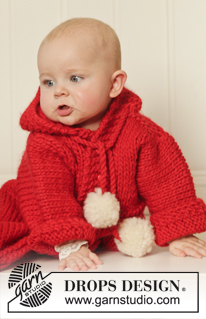




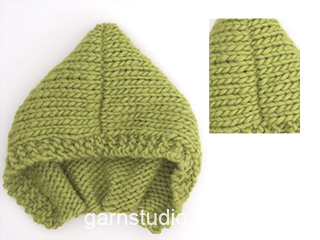
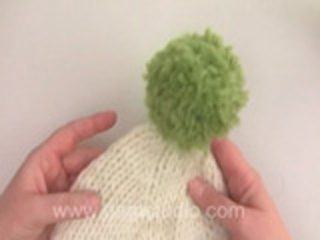



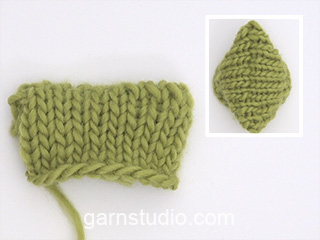












































Comments / Questions (32)
Jet holder på å strikker oppskriften som pose til bilsete, men klarer ikke å forstå om det skal lages hull til setebeltet på begge forstykkene eller bare på høyre side.? Så forstår jeg heller ikke hvordan jeg evt skal måle 47 cm fra skulderen for å lage hullet til beltet. Dette må jo måles fra venstre side som jeg allerede har strikket ferdig, eller måljeger rekke opp igjen .? Dette burde vært bedre beskrevet i oppskriften syns jeg.
03.04.2020 - 23:52DROPS Design answered:
Du strikker kjøreposen i et stykke. Du starter med bakstykket, fell av til det første hullet til setebelte på bakstykket når arbeidet måler ca 16-20-23 (28-33) cm. Nå strikkes det videre oppover, det legges ut til ermene, erme strikkes ferdig, det felles til ermene, strikk til riktig mål og fell til hals, nå settes maskene i høyre side på 1 tråd og venstre forstykke strikkes. Her settes det et merke du skal måle fra når du skal lage hull til setebelte på forstykket. Det 2. hullet til setebeltet lages når venstre og høyre forstykket er satt sammen og arbeidet målt fra skulderen er 42-47-52 (58-59) cm. God Fornøyelsen!
17.04.2020 - 12:06När rändern med rätstickning är gjorda på framstyckena så ska båda framstyckena sättas på samma sticka. Innebär det att man stickar ihop dessa stycken från och med där? Jag har ju bara hunnit göra 3 knapphål fram till dess och det blir ju väldigt kort öppning eftersom arbetet endast mäter ca 22 cm. Ska man sticka slätstickning på varje framstycke, var för sig tills alla knapphål är gjorda? Detta framgår inte i beskrivningen.
22.04.2019 - 22:22DROPS Design answered:
Hej, jo höger och vänster framst stickas ihop, men du hinner göra alla knapphål innan dess (sista knapphål görs då framkanten mäter 19-20-21-22-23 cm.
23.04.2019 - 14:28J'aimerais trouver un nid d'ange facile à faire et le patron gratuit
11.02.2019 - 00:55DROPS Design answered:
Chere Marie-Josee, cliquez sur ce lien: https://www.garnstudio.com/search.php?action=search&w=nid+d%27ange&mt=0&c=0&k=0&y=0&yg=0&lang=fr. Bon tricot!
11.02.2019 - 06:53Do you add the 7 stitches at the end of rowr or after the band
31.05.2018 - 19:18DROPS Design answered:
Dear Mrs Weatherall, on left front piece, you cast on 7 sts at the end of a row from WS (= towards mid front) = after the 6 sts in garter st. Happy knitting!
01.06.2018 - 09:08Buongiorno, che tecnica posso utilizzare per cucire i fianchi? Grazie Loredana
06.10.2017 - 10:25DROPS Design answered:
Buongiorno Loredana. Può cucire i fianchi seguendo le indicazioni del video che le alleghiamo. Buon lavoro!
06.10.2017 - 10:41Buongiorno! Vorrei realizzare questo modello....l'unico dubbio mi viene dal filato utilizzato. Non rilascia troppi peletti? Eventualmente come sostituirlo? Grazie Loredana
16.08.2017 - 10:43DROPS Design answered:
Buongiorno Loredana. Può usare un altro filato del gruppo filato E oppure un filato del gruppo filato C messo doppio. Può per esempio valutare di usare Big Merino messa doppia. Verifichi sempre di ottenere lo stesso campione indicato nel modello. Buon lavoro!
16.08.2017 - 11:18Beste, Bij de linkervoorpand worden 8 nieuwe steken opgezet. Worden die steken later als de 6 ribbelsteken van de voorbies gebreid
22.12.2016 - 10:53DROPS Design answered:
Hoi Nancy. Ja, klopt.
22.12.2016 - 14:25When picking up the 37 stitches for the hood do you pick up the the stitches along the two front bands? Or start picking them after the band and include the stitches on the other band? Or don't pick up stitches on any of the two front bands?
26.11.2016 - 04:41DROPS Design answered:
Dear Judy, sts for hood are picked up over the front band sts on each side + around whole neckline. Happy knitting!
28.11.2016 - 09:04Dobry den, prosim Vas, nerozumiem navodu v casti lavy predny diel. A to od "upleteme rubovou radu a pak nahodime na konci rady (smerem k okraji predniho dilu) 7 novych ok = 37 ok. Nad temito 7 novymi oky upleteme 1 vroubek, ostatni oka plezeme jako dosud. Pokracujeme licovym zerzejem pricemz 6 ok legy a 3 oka lemu rukavu pleteme stale vroubkem." - mozete mi vysvetlit na ktoru stranu pleteniny pridam 7 ok a ako tych 7 ok dalej pletiem - akym vzorom? Nejak mi to nesedi. :-)
12.10.2016 - 18:32Henriette Sørensen wrote:
Hi, I'm going to knit this model in a few days, and I'm curios as to how the baby actually gets into the suit. The drawning doesn't seem to show it. Where and how do the baby enter?
31.05.2016 - 14:07DROPS Design answered:
Dear Mrs Sørensen, there are front band edges on each front pieces with buttons/buttonholes to close the bunting bag. Happy knnitting!
31.05.2016 - 15:10